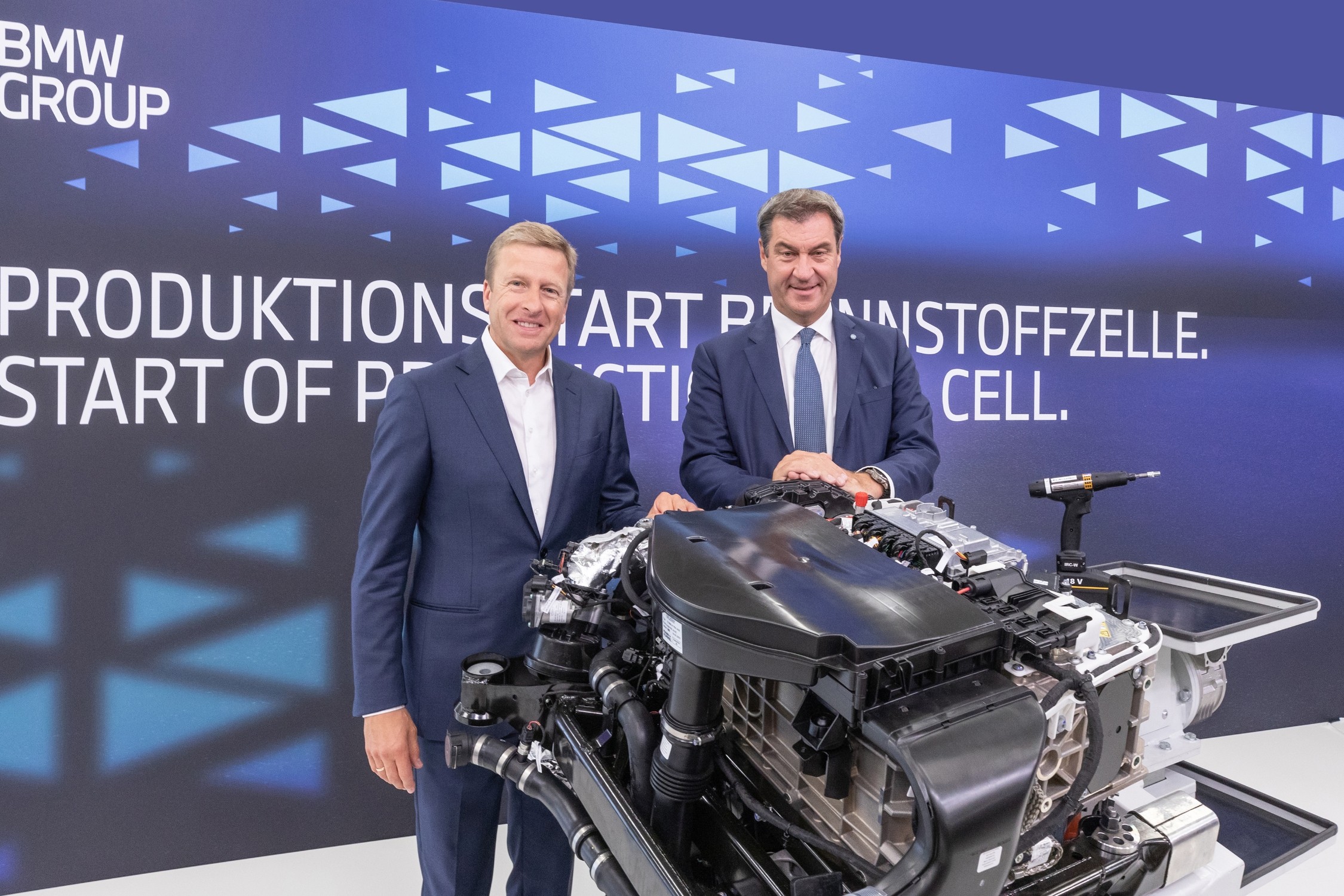 BMW Group startet Produktion von Brennstoffzellensystemen für BMW iX5 Hydrogen. Foto: BMW GROUP
BMW Group startet Produktion von Brennstoffzellensystemen für BMW iX5 Hydrogen. Foto: BMW GROUP
On August 31, Bavarian Minister-President Dr. Markus Söder, Bavarian State Minister for Economic Affairs, Regional Development and Energy Hubert Aiwanger, Chairman of the Board of Management of BMW AG Oliver Zipse and Frank Weber, Member of the Board of Management of BMW AG for Development, commissioned the production of fuel cell systems at the in-house Hydrogen Competence Center in Munich. The occasion is the small series of the BMW iX5 Hydrogen, which will be used worldwide for testing and demonstration purposes from the end of this year. The combination of fuel cell and power battery adds a globally unique drive system in the premium segment to the range.
From now on, the BMW Group will produce highly efficient fuel cell systems at its own hydrogen competence center in Munich. The technology is one of the core components in the BMW iX5 Hydrogen and has a continuous high output of 125 kW/170 hp. Combined with an electric motor from the fifth generation of BMW eDrive technology and a power battery developed specifically for this vehicle, the vehicle’s powertrain puts 275 kW/374 hp on the road. For the small series, the development team integrated the high-performance drive system, consisting of two hydrogen tanks, the fuel cell and the electric motor, into the existing architecture of the BMW X5. During final winter testing in Sweden at the beginning of this year, the BMW iX5 Hydrogen was already able to demonstrate its high suitability for everyday use – even at very low temperatures.
The convincing test results of the new small series are based on the BMW Group’s extensive experience with hydrogen as a drive technology. Hydrogen combustion engines were used even before the fuel cell. For efficiency reasons, the BMW Group decided to continue its development in this area from 2015 with the BMW 5 Series GT Hydrogen Cell based on fuel cell technology. With the know-how from the field of conventional drive technologies and the comprehensive efficiency requirements for all vehicles, fuel cell technology has been successively optimized to date.
Production of fuel cell systems in Munich
In the fuel cell, the chemical reaction takes place between the hydrogen from the tanks and the oxygen from the ambient air. For a high efficiency of the drive, an even supply of the two media to the membrane in the fuel cell is crucial. In addition to technological analogues to the combustion engine such as the charge air cooler, air filter, control units and sensor technology, the BMW Group has also developed special hydrogen components for the new fuel cell system. These include, for example, the high-revving compressor with turbine or a high-voltage coolant pump.
The BMW Group is obtaining the individual fuel cells required for production of the BMW iX5 Hydrogen from Toyota Motor Corporation. Both companies can look back on many years of trusting cooperation and have already been working together on fuel cell drives since 2013. The fuel cell systems are manufactured in two main steps. First, the individual fuel cells are stacked to form a so-called fuel cell stack. In the next step, the assembly of all other components into a complete fuel cell system takes place.
The so-called “stacking”, i.e. the stacking of the fuel cells, is a fully automated process. After the individual components are inspected for damage, the stack is mechanically pressed with five tons of force and fitted with a housing. The stack housing is manufactured in the light metal foundry at the BMW Group plant in Landshut using the so-called sand casting process. In a process specially designed for small series production, liquid aluminum is poured into a mold made of compacted sand molded with resin. The media pressure plate, which supplies hydrogen and oxygen to the fuel cell stack, also consists of plastic and light metal castings from the Landshut plant. The media pressure plate seals the stack housing gas- and water-tight.
Final assembly of the fuel cell stack includes a voltage test and comprehensive tests of the chemical reaction within the cells. Finally, all components are assembled into a complete system in the assembly area. During system assembly, other components such as the compressor, the anode and cathode, the high-voltage coolant pump and the wiring harness are mounted. www.bmw-group.com